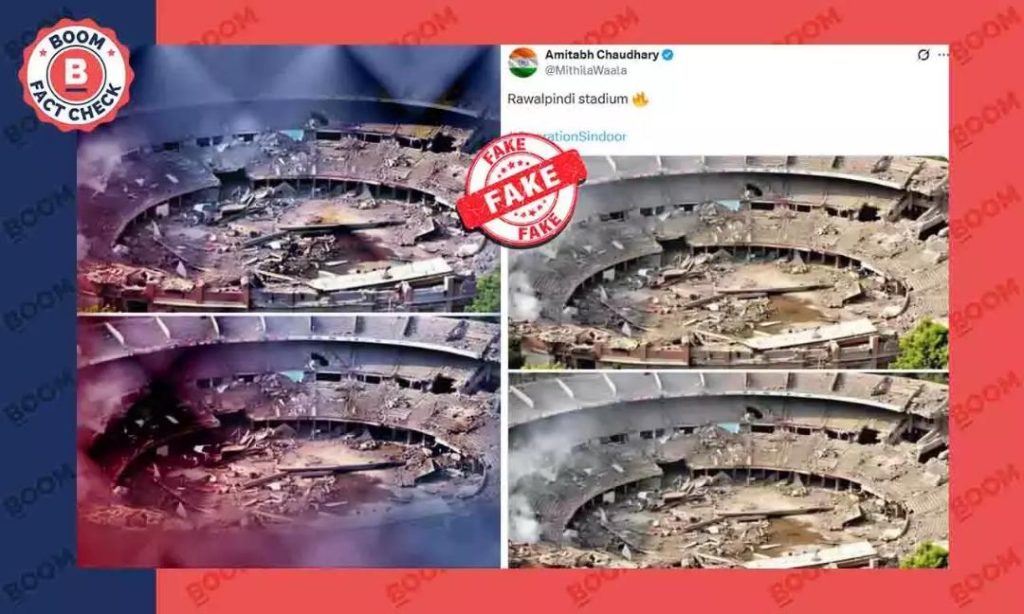
Viral Pic Showing the Destruction of Rawalpindi Stadium is AI-Generated
Social media can be a powerful tool for spreading information, but it can also be a breeding ground for misinformation and disinformation. In recent times, we’ve seen a surge in the spread of fake news and manipulated images that can have serious consequences. One such example is a widely circulated image that claimed to show the destruction of the Rawalpindi Cricket Stadium in Pakistan, allegedly carried out by the Indian Army during Operation Sindoor. BOOM, a fact-checking website, has recently debunked this image as AI-generated, and in this blog post, we’ll delve into the details of this story and the methods used to verify its authenticity.
The image, which went viral on social media, shows a devastating scene of destruction at the Rawalpindi Cricket Stadium, with buildings in ruins, debris scattered everywhere, and what appears to be a significant amount of damage. The accompanying text claimed that this was the result of an attack by the Indian Army during Operation Sindoor, a military operation that was launched in 1971 during the Indo-Pakistani War.
However, BOOM’s fact-checking team was quick to investigate this claim and used AI detection tools to analyze the image. After conducting a thorough examination, they found a 97.4% likelihood that the image was fabricated. But how did they come to this conclusion?
BOOM’s team used a combination of AI-powered tools and human verification to analyze the image. They began by using a tool called DeepFake Detection Tool, which is specifically designed to detect AI-generated content. This tool analyzed the image’s metadata and found several red flags that suggested it was likely fabricated.
One of the key indicators was the image’s resolution and file size. The image was unusually high-resolution and large in size, which is uncommon for a real-world image. Additionally, the image lacked any visible metadata, such as EXIF data, which is typically present in real-world images.
BOOM’s team also analyzed the image’s visual characteristics, including its color palette, textures, and patterns. They found that the image had an unnatural and uniform color tone, which is often a giveaway of AI-generated content. The team also noticed that the image’s textures and patterns were overly smooth and lacked the characteristic imperfections found in real-world images.
To further verify their findings, BOOM’s team compared the image to real-world images of the Rawalpindi Cricket Stadium. They found that the alleged destruction caused by the Indian Army was inconsistent with the actual condition of the stadium, which has been extensively documented through official sources and independent reporting.
The fact that this image was AI-generated has significant implications for the spread of misinformation and disinformation. With the ability to create convincing AI-generated content, it’s now easier than ever for malicious actors to spread false information and manipulate public opinion.
In the age of social media, it’s more important than ever to be vigilant and critical consumers of information. Before sharing or believing an image or news story, it’s essential to verify its authenticity and accuracy. BOOM’s fact-checking team has set an excellent example by using AI-powered tools to detect and debunk AI-generated content, and we can all learn from their efforts.
In conclusion, the viral image claiming to show the destruction of the Rawalpindi Cricket Stadium is AI-generated, and not a genuine representation of an event that allegedly occurred during Operation Sindoor. BOOM’s fact-checking team has demonstrated the importance of using AI-powered tools to detect and debunk misinformation, and we can all benefit from their expertise.
Source: https://www.boomlive.in/factcheck-ai-generated-image-of-rawalpindi-cricket-stadium-destruction






